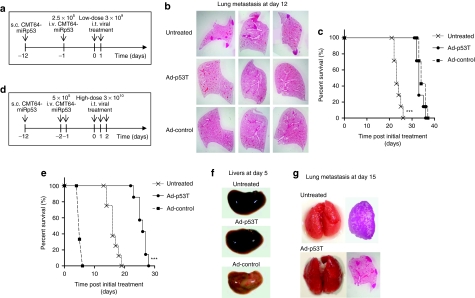Figure 6.
Highly tumor selectivity of Ad-p53T leads to a therapeutic benefit after high-dose virotherapy in animals with large burden of metastases. Primary s.c. tumors and lung metastases of CMT64-miRp53 cells were established in syngeneic C57Bl/6 mice and subsequently treated according to the therapeutic scheme in a. (b) At the time of treatment start, primary s.c. tumors were treated twice on two subsequent days by intratumoral injection of 3 × 109 ifu. Therapeutic efficacy of induced systemic antitumoral immunity was investigated on noninfected lung metastases. For this purpose, mice were harvested at day 12 after initial treatment, lungs were inflated with paraformaldehyde (PFA) solution for fixation, and hematoxylin and eosin (H&E)–stained lung sections were microscopically investigated to determine the lung metastases burden (each image is shown as a representative example of n = 3 mice per group). (c) Survival of mice was monitored and determined (***P < 0.0001, log-rank test; n = 7 mice per group). All animals died due to lung metastases. However, the results show that oncolytic infection of the primary tumor led to significantly prolonged survival. (d) Therapeutic scheme of a high-dose tumor treatment model with extended metastases burden: an increased dose of CMT64-miRp53 cells were injected i.v. to induce lung metastases earlier as compared to the previous scheme. Subcutaneously grown tumors (induced at day 12) were threefold i.t. infected with high doses of infectious particles (1 × 1010 ifu). (e) Survival of mice was monitored after treatment according to the scheme in d (***P < 0.0001, log-rank test; n = 8 mice per group). (f) Explanted livers at day 5 after initial treatment (one liver as representative example of n = 4 mice per group) were macroscopically investigated for signs of liver injury. (g) At day 15, mice were harvested, lungs were inflated with PFA solution for fixation purposes and were examined macroscopically (each image is shown as a representative example of n = 3 mice per group). Extent of lung metastases burden was investigated on H&E-stained lung sections. The results show that viral infection of the primary tumor, irrespective of the degree of selectivity, induces systemic antitumoral immunity that is therapeutically effective against distant, noninfected lung metastases. The results obtained from a model that stringently addresses dose-related toxicity demonstrate that highly tumor-selective adenoviruses can be applied at increased doses to achieve therapeutic efficacy without lethal hepatotoxicity. ifu, infection forming units.

